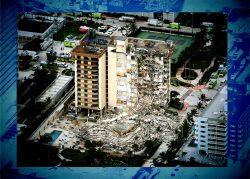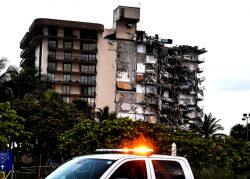For The Real Deal’s most recent coverage of the Surfside condo collapse, please visit this link.
UPDATED, June 28, 6:51 p.m.: In the search for a cause of the Surfside condo collapse, more details are emerging about re-construction work needed at the building, as 150 remain missing and 11 are confirmed dead.
Champlain Towers South’s condo association had put out bids for concrete restoration work, as part of the required 40-year recertification, the association’s lawyer, Donna Berger, told The Real Deal. But she pushed back against a lawsuit claiming that the association was responsible for the collapse. The suit, filed late Thursday, seeks class action status and more than $5 million in damages to victims.
Prior to the collapse, the association had hired engineer Frank Morabito of Morabito Consultants to inspect the building constructed in 1981 for the recertification.
Morabito Consultants in a statement issued Saturday afternoon in part said that its report to the association in 2018 “detailed significant cracks and breaks in the concrete, which required repairs to ensure the safety of the residents and the public.”
The association then hired Morabito Consultants again in June 2020 to provide a plan specifying the needed repair and restoration work.
Morabito Consultants added it is “saddened by the tragic events” and is working with investigators to determine the cause of the collapse.
The association was paying for repairs with a $12 million line of credit, and each unit owner had an $8,000 special assessment for the roof replacement, according to Berger.
The oceanfront portion of the 12-story south tower came crumbling down at about 1:30 a.m. Thursday, crushing more than 50 units in the Champlain Towers South at 8777 Collins Avenue in Surfside.
On Friday, loved ones of those still missing clung to hope that survivors would be found, even while coming to terms with the grim reality of more expected deaths. Authorities identified one of the confirmed victims as Stacie Fang, mother of the teenage boy whose rescue was captured in dramatic footage hours after the collapse.
As first responders continued to make their way through the rubble, speculation abounded as to what caused the collapse. Official answers likely won’t come for some time.
Fingers point in different directions
Unit owner Manuel Drezner, who filed the first civil lawsuit, pointed a finger at the condo association for failing to implement adequate safety measures. Drezner, who was not at the building at the time, claims in the suit the association failed to ensure adequate safety measures.
The suit cites public comments by Ken Direktor, another association attorney, that “repair needs had been identified,” but were not done, according to the complaint.
Association attorney Berger, of the law firm Becker, challenged Drezner’s allegations. She said the engineer she spoke with told her it was an issue with the subsurface of the building, such as pilings dug in at construction completed more than 40 years ago.
The re-roof work was already underway, with some speculating that the heavy machinery on top of the building contributed to the collapse. Berger refuted this claim, as well as the allegation that existing cracks were to blame.
“A building doesn’t fall down because you work on a roof or because there are 16 cracks on the stucco,” she said, although she was not referring to Champlain Towers South. “All these buildings along the coast all get beat up because of the weather. It is what it is. It’s a desirable place to live.”
The volunteer condo board was doing the right thing by following the priority list for work generated by the engineer who was hired for the recertification inspection, Berger added. The roof was prioritized due to the start of the hurricane season on June 1.
Read more


Attorney Brad Sohn, who represents Drezner, told TRD that he and his client stand by the claims and believe the collapse was preventable. The lawsuit is needed to ensure all records pertinent to an investigation will be preserved, Sohn added in a press release.
Berger did not have the engineer’s report and did not know specifics of the concrete issues the engineer identified. The town of Surfside has yet to release information related to the recertification.
Concrete: a common issue
Concrete restoration is big business in Florida, as many buildings deal with concrete issues. Typically, condos have to deal with concrete problems on the balconies, delamination of stucco, exposed rebar, cracks in the concrete and rust spots, according to experts.
“You can drive up and down the A1A on the ocean and you will see a number of these concrete restorations on a typical day,” said Paul Danforth, an engineer with Universal Engineering.
Champlain Towers South had been sinking at about 2 millimeters a year in the 1990s, although the rate may have changed since then, according to a Florida International University study concluded last year. The northeast portion of the building is what collapsed early Thursday morning.
Berger said the study “reinforces” the speculation by engineers she has spoken to that this was a subsurface problem. She questioned why FIU, a state school, did not raise the alarm once its study showed the building had been sinking.
Architect Kobi Karp pointed to the fact that the ocean-facing portion of the building fell.
“If you look closely at the building, you see that the failure of the building is the northeast rectangle, yet the southwest L stands by itself,” said Karp, who is not involved. “You wonder why did that demise occur, yet the rest of the building stood up?”
Experts said that even while doing work such as concrete restoration and repair, there will likely be issues that engineers can’t visually see or access without the use of X-ray technology.
On top of that, property owners are not required to do any major inspections before a building turns 40. The level of maintenance performed by a condo building varies from condo to condo and is typically dependent on the association.
“Generally speaking, it is up to the owner of the building, up to the association to deal with it,” Karp said.
Matthew Flax of Flax & Associates, a general contractor, is one of many who said that associations often get started on their recertifications too late due to a lack of cash. It can also be difficult in such a hot real estate market to get qualified labor and contractors for big projects, he added.
Champlain Towers South was built 40 years ago, “so they had just started, when maybe they should have started the process in prior years,” Flax speculated.
The calamity has put into question whether a recertification after 40 years, the minimum required in Miami-Dade County, is enough. Karp and other experts said there will likely be changes to this requirement and the building code and certification requirements, depending on what forensic engineers determine as the cause of the collapse.
“We have an opportunity to create what we did post-1992, post Hurricane Andrew where the hurricane blew through homes built on wood frames,” Karp said. “We have the responsibility to ourselves to look into how we can maintain, sustain these structures.”
This story has been updated to reflect the correct special assessment and cost of repairs to unit owners as well as the engineering consultant’s statement.
